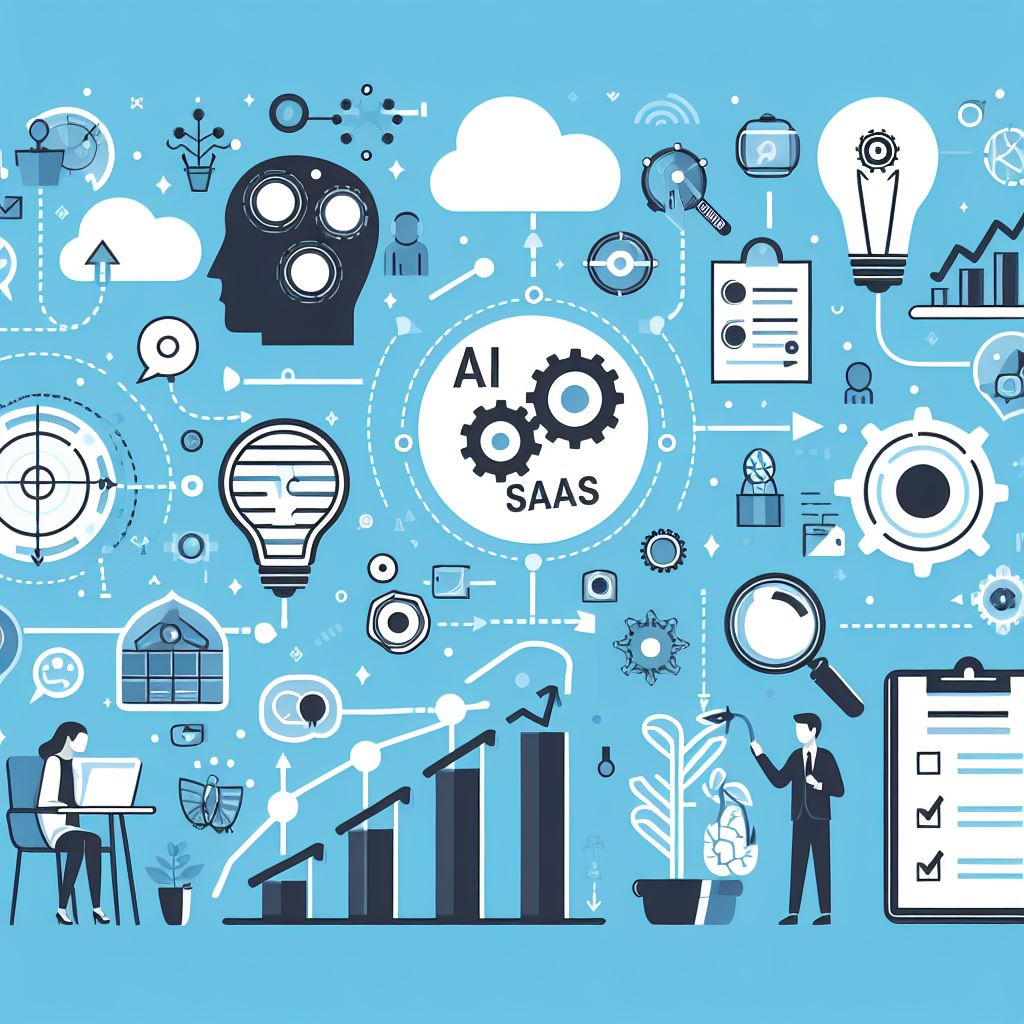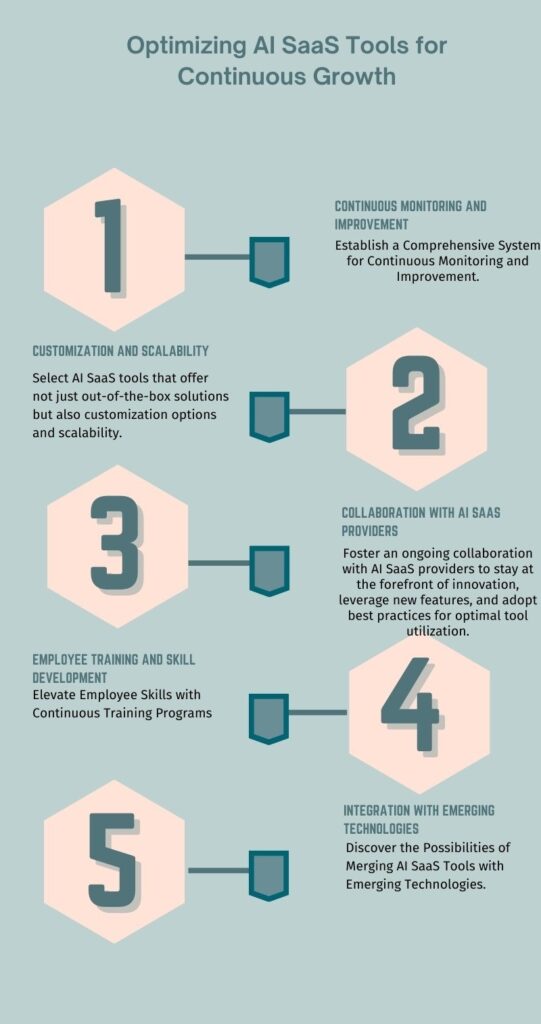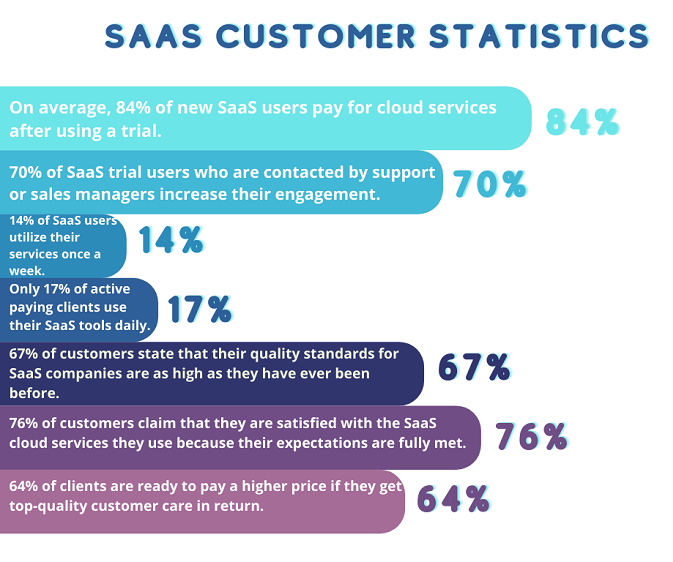Table of Contents
Introduction
Welcome to “The Ultimate Guide to Implementing AI SaaS Tools for Business Growth.” In the rapidly evolving landscape of business technology, Artificial Intelligence (AI) Software as a Service (SaaS) tools have emerged as pivotal catalysts for organizational advancement. In this comprehensive guide, we’ll delve into the intricacies of leveraging AI SaaS for robust business growth.
Why AI SaaS for Business Growth?
AI SaaS tools are not merely technological trends; they are strategic assets that can revolutionize how businesses operate, analyze data, and make decisions. As we navigate through this guide, we’ll explore the profound impact of integrating AI SaaS into your business strategy.
Understanding AI SaaS Tools
In this section, we will define AI SaaS tools, explore the various types available, and highlight the substantial benefits they bring to businesses.
AI SaaS tools, or Artificial Intelligence Software as a Service tool, are cloud-based solutions that leverage AI algorithms and capabilities to offer businesses scalable and efficient functionalities. These tools span a wide range of applications, from data analytics and predictive modeling to natural language processing and machine learning.
Types of AI SaaS Tools
- Data Analytics Platforms:
- Utilized for processing and analyzing vast datasets to extract valuable insights.
- Examples: Google Analytics, Tableau, and IBM Cognos Analytics.
- Predictive Modeling Tools:
- Employed to forecast future trends based on historical data patterns.
- Examples: RapidMiner, KNIME, and DataRobot.
- Natural Language Processing (NLP) Solutions:
- Focus on understanding and interpreting human language.
- Examples: Amazon Comprehend, and Microsoft Azure Text Analytics.
- Machine Learning Platforms:
- Enable the development, training, and deployment of machine learning models.
- Examples: TensorFlow, PyTorch, and scikit-learn.
Benefits of AI SaaS Tools for Businesses
- Enhanced Efficiency: AI SaaS tools automate repetitive tasks, allowing teams to focus on high-value activities.
- Data-Driven Decision-Making: Analyzing large datasets in real-time enables informed and strategic decision-making.
- Cost Savings: Cloud-based solutions eliminate the need for extensive hardware infrastructure and maintenance.
- Scalability: Businesses can scale their AI capabilities based on evolving needs without major investments.
Implementing AI SaaS: Step-by-Step Guide
Implementing AI SaaS tools in your business involves a systematic approach to ensure successful integration and maximize the benefits. This section provides a step-by-step guide to navigating the implementation process.

Setting Clear Objectives and Goals
The foundation of a successful AI SaaS implementation lies in establishing clear objectives and goals. This involves collaboration between key stakeholders, including department heads, IT professionals, and decision-makers.
1. Define Clear Objectives:
- Clearly outline the goals you aim to achieve with the implementation of AI SaaS tools.
- Example: Improve operational efficiency, enhance customer experience, or streamline data analysis.
2. Create Measurable Goals:
- Develop specific, measurable, achievable, relevant, and time-bound (SMART) goals.
- Example: Reduce manual data entry errors by 20% within the first quarter.
3. Align with Business Strategy:
- Ensure that the established objectives align with your broader business strategy.
- Example: If customer engagement is a priority, set goals related to improving customer interactions.
Assessing Data Readiness and Quality
Data is the lifeblood of AI, and ensuring its readiness and quality are paramount for a successful implementation.
1. Data Assessment:
Conduct a thorough assessment of your existing data, identifying sources, formats, and potential gaps.
Example: Determine if data from various departments can be consolidated for comprehensive analysis.
2. Data Cleaning and Enrichment:
Cleanse and enrich your data to enhance its quality and reliability.
Example: Use data cleaning tools to identify and rectify inaccuracies or inconsistencies.
3. Data Security Measures:
Implement robust data security measures to protect sensitive information throughout the AI SaaS process.
Example: Utilize encryption protocols, access controls, and regular security audits.
Employee Training and Change Management
The success of AI SaaS implementation is not just about technology; it’s about people. Adequate training and change management strategies are crucial.
1. Employee Training Programs:
- Develop comprehensive training programs to familiarize employees with the new AI SaaS tools.
- Example: Provide hands-on workshops, online courses, or access to training resources.
2. Change Management Strategies:
- Implement change management strategies to address resistance and facilitate a smooth transition.
- Example: Communicate the benefits of AI SaaS adoption, involve employees in the process, and address concerns proactively.
Integration with Existing Systems
Seamless integration with existing systems is key to avoiding disruptions and optimizing the efficiency of AI SaaS tools.
1. Compatibility Checks:
- Ensure that the selected AI SaaS tool is compatible with your current software and systems.
- Example: Verify integration capabilities with CRM, ERP, and other essential systems.
2. APIs and Connectors:
- Leverage available APIs and connectors to facilitate smooth data flow between systems.
- Example: Use pre-built connectors or develop custom APIs to bridge the gap between AI SaaS and other systems.
Testing and Quality Assurance
Thorough testing is essential to identify and rectify potential issues before full-scale implementation.
1. Comprehensive Testing Protocols:
- Develop comprehensive testing protocols to assess the functionality and performance of AI SaaS tools.
- Example: Conduct unit testing, integration testing, and user acceptance testing.
2. Quality Assurance Measures:
- Implement quality assurance measures to ensure that the AI SaaS implementation aligns with established objectives.
- Example: Regularly monitor and evaluate key performance indicators (KPIs) to gauge the effectiveness of the system.
Overcoming Implementation Challenges
Implementing AI SaaS tools, while promising significant benefits, comes with its set of challenges. Awareness and proactive strategies are key to overcoming these hurdles. In this section, we’ll explore common pitfalls and strategies to avoid them.
Common Pitfalls and How to Avoid Them
1. Lack of Clear Objectives:
- Pitfall: Failing to define clear objectives can lead to a lack of direction and measurable outcomes, impacting the overall success of AI SaaS implementation.
- Avoidance: Mitigate this risk by investing time and effort in the initial planning phase. Clearly articulate the objectives, ensuring they align with broader business goals and are communicated effectively to all stakeholders.
2. Insufficient Data Quality:
- Pitfall: Poor data quality can compromise the accuracy and reliability of AI-generated insights, resulting in flawed decision-making.
- Avoidance: Prioritize data quality assurance measures. Implement robust data cleaning and enrichment processes to address issues before they impact the implementation phase. Regularly audit and maintain data integrity throughout the AI SaaS lifecycle.
3. Resistance to Change:
- Pitfall: Employee resistance can hinder the adoption of AI SaaS tools, leading to suboptimal utilization and slower integration into daily workflows.
- Avoidance: Proactively address resistance through change management strategies. Communicate the benefits of AI SaaS adoption, involve employees in the decision-making process, and provide adequate support and training to ensure a smooth transition.
4. Inadequate Training:
- Pitfall: Insufficient training can lead to underutilization of AI SaaS capabilities, limiting the overall impact on operational efficiency.
- Avoidance: Prioritize comprehensive training programs tailored to different user groups. Offer continuous learning resources and support to ensure that employees feel confident and competent in utilizing the full range of AI SaaS functionalities.
Real-world Case Studies
The real-world application of AI SaaS tools is best illustrated through case studies that showcase successful implementations, challenges faced, and the tangible benefits achieved. In this section, we’ll delve into two compelling case studies, providing insights into the transformative power of AI SaaS.
Case Study 1: Enhancing Personalization for E-Commerce Excellence
Challenge:
E-Commerce Emporium, a leading online retailer, encountered challenges in boosting customer engagement and conversion rates. The lack of personalized experiences led to a decline in customer satisfaction and hindered the potential for repeat business.
Solution:
To address this, E-Commerce Emporium implemented an advanced AI SaaS tool, known as “PersonaFlow.” This tool utilized sophisticated machine learning algorithms to analyze individual customer behaviors, preferences, and purchase history in real time.
Results:
- The surge in Conversion Rates: With “PersonaFlow” dynamically adjusting website content, product recommendations, and marketing messages, E-Commerce Emporium witnessed a remarkable increase in conversion rates.
- Elevated Customer Satisfaction: The tailored approach resulted in a surge in customer satisfaction, evidenced by positive feedback, increased customer loyalty, and a higher frequency of repeat business.
Case Study 2: Revolutionizing Logistics with Predictive Efficiency
Challenge:
GlobalLogistics Corp, a multinational logistics giant, grappled with inefficiencies in its expansive supply chain operations. Delays, increased costs, and suboptimal inventory management were significant pain points.
Solution:
To streamline their operations, GlobalLogistics Corp integrated cutting-edge AI SaaS tools, including the “LogiOptimize” platform. This tool leveraged predictive analytics algorithms to anticipate demand fluctuations, optimize route planning, and enhance inventory management.
Results:
- Significant Cost Savings: The implementation of “LogiOptimize” led to substantial cost savings, including reduced fuel consumption, minimized delays, and optimal inventory levels.
- Heightened Operational Efficiency: GlobalLogistics Corp experienced a marked increase in operational efficiency. Streamlined processes facilitated faster order fulfillment, contributing to improved client satisfaction.
These vividly detailed case studies exemplify the diverse applications of AI SaaS tools and the positive transformations they can bring to businesses. As we proceed, we’ll discuss strategies for optimizing AI SaaS tools to foster continuous growth.
Optimizing AI SaaS Tools for Continuous Growth
Having explored inspiring case studies, we now shift our focus to strategies that go beyond implementation – strategies for optimizing AI SaaS tools to ensure sustained growth and unlock their full potential.

1. Continuous Monitoring and Improvement
Strategy:
Implement a robust system for continuous monitoring and improvement, creating an adaptive framework that aligns with evolving business landscapes and advances in technology.
- Implementation Example: Utilize a comprehensive set of key performance indicators (KPIs) to meticulously monitor the effectiveness of AI SaaS tools. Regularly conduct in-depth analyses of data insights to identify nuances, trends, and potential areas for enhancement.
2. Customization and Scalability
Strategy:
Select AI SaaS tools that offer not just out-of-the-box solutions but also customization options and scalability, ensuring adaptability to the dynamic needs of your evolving business.
- Implementation Example: Opt for tools with modular features that can be finely tuned to match specific business requirements. Ensure scalability, allowing the tools to seamlessly accommodate surges in data volumes and evolving user demands.
3. Collaboration with AI SaaS Providers
Strategy:
Foster an ongoing collaboration with AI SaaS providers to stay at the forefront of innovation, leverage new features, and adopt best practices for optimal tool utilization.
- Implementation Example: Establish regular and open channels of communication with your AI SaaS provider. Actively participate in webinars, workshops, and forums hosted by the provider to stay well-informed about updates, upcoming features, and industry insights.
4. Employee Training and Skill Development
Strategy:
Invest in continuous training programs to elevate the skills of employees interacting with AI SaaS tools. Empower your workforce with the knowledge needed for proficient and innovative tool utilization.
- Implementation Example: Provide employees with access to advanced training modules, immersive workshops, and certifications tailored to the latest features and functionalities of AI SaaS tools. Foster a culture of continuous learning to ensure the workforce remains adept in utilizing the tools to their full potential.
5. Integration with Emerging Technologies
Strategy:
Explore opportunities to integrate AI SaaS tools with cutting-edge and emerging technologies. This forward-thinking approach positions your business at the vanguard of innovation.
- Implementation Example: Investigate how AI SaaS tools can synergize with emerging technologies such as blockchain or augmented reality. Explore possibilities for creating a technological ecosystem where these innovations complement each other, amplifying the overall capabilities of your business.
Anticipating Future Trends in AI SaaS for Unprecedented Growth
As we navigate the ever-evolving landscape of AI SaaS, it’s crucial to anticipate future trends that will shape the trajectory of business growth. In this section, we’ll delve into emerging trends that promise to redefine the way businesses harness the power of AI SaaS.
Embracing Explainable AI for Transparency
Trend:
The demand for transparency in AI decision-making processes is rising. Explainable AI, which provides clear insights into how AI models arrive at specific conclusions, is gaining prominence.
- Implications for Business Growth: Businesses adopting explainable AI can build trust with customers, regulators, and internal stakeholders. Clear insights into AI decisions enhance credibility and facilitate better decision-making.
Integration of AI with Edge Computing
Trend:
Edge computing, where data is processed closer to the source of generation, is becoming integral. The integration of AI with edge computing enables real-time decision-making and reduces latency.
- Implications for Business Growth: Improved processing speeds and reduced latency enhance the efficiency of AI applications. Businesses can capitalize on quicker insights, leading to faster response times and a competitive edge.
Augmented Analytics for Data-driven Decision-Making
Trend:
Augmented analytics combines AI and analytics to automate data preparation, insight discovery, and sharing. This trend empowers business users to make data-driven decisions with minimal intervention from data scientists.
- Implications for Business Growth: Increased accessibility to data insights enables faster decision-making across various business functions. Augmented analytics democratizes data, ensuring that decision-makers at all levels can harness its power.
AI-driven Personalization in Customer Engagement
Trend:
AI-driven personalization is evolving beyond basic recommendations. Advanced AI algorithms analyze vast datasets to predict individual preferences, enabling hyper-personalized customer experiences.
- Implications for Business Growth: Enhanced customer engagement and satisfaction lead to increased loyalty and repeat business. Businesses that master AI-driven personalization gain a competitive advantage in the market.
Sustainable AI Practices for Corporate Responsibility
Trend:
The integration of sustainable practices in AI development and usage is gaining attention. Businesses are incorporating ethical considerations, environmental impact assessments, and responsible AI practices.
- Implications for Business Growth: Embracing sustainable AI practices not only fulfills corporate social responsibility but also resonates positively with customers. It can attract a conscious consumer base and enhance brand reputation.
Key Takeaways and Actionable Insights for AI SaaS Success
As we conclude our journey through the realms of AI SaaS and its transformative potential, let’s distill key takeaways and provide actionable insights for businesses aiming to leverage AI SaaS for unprecedented growth.
Key Takeaways:
- Strategic Implementation Matters:
- Carefully define clear objectives and align them with broader business goals before implementing AI SaaS tools.
- Continuous Monitoring and Adaptation:
- Establish a system for continuous monitoring, leveraging data insights to adapt and improve the effectiveness of AI SaaS tools over time.
- Invest in Employee Training:
- Empower your workforce with ongoing training programs to ensure they are well-equipped to harness the full potential of AI SaaS tools.
- Explore Integration with Emerging Technologies:
- Stay at the forefront of innovation by exploring opportunities to integrate AI SaaS tools with emerging technologies, amplifying overall business capabilities.
- Anticipate Future Trends:
- Be proactive in anticipating and embracing emerging trends such as explainable AI, integration with edge computing, augmented analytics, and AI-driven personalization.
Actionable Insights:
- Establish a Cross-functional Team:
- Form a cross-functional team involving key stakeholders, IT professionals, and department heads to ensure a holistic approach to AI SaaS implementation.
- Regularly Assess Business Needs:
- Conduct periodic assessments of business needs and objectives to ensure that AI SaaS tools align with evolving organizational priorities.
- Foster Collaboration with Providers:
- Foster an ongoing collaboration with AI SaaS providers, actively participating in forums and workshops to stay informed about updates and best practices.
- Prioritize Sustainability and Ethics:
- Integrate sustainable and ethical considerations into AI practices, reflecting corporate responsibility and resonating positively with consumers.
- Encourage Innovation:
- Cultivate a culture of innovation within the organization, encouraging employees to explore creative applications of AI SaaS tools.
By embracing these takeaways and actionable insights, businesses can not only implement AI SaaS effectively but also position themselves for sustained growth, innovation, and success in an ever-evolving digital landscape.

Conclusion
In our exploration of the vast landscape of AI SaaS, we’ve uncovered the transformative power that these tools hold for businesses seeking growth, efficiency, and innovation. As you embark on your journey into the realm of AI SaaS excellence, keep the following guiding principles in mind:
Embrace the Fusion of Strategy and Technology
The successful implementation of AI SaaS is not solely a technological endeavor. It’s a strategic fusion of technology with clear business objectives. Define your goals, align them with overarching strategies, and let technology be the catalyst for achieving your vision.
Commit to Continuous Improvement
The world of AI and SaaS is dynamic, with innovations emerging regularly. Commit to a culture of continuous improvement. Monitor performance, gather insights, and iterate on your strategies to keep pace with evolving technologies and market demands.
Empower Your Team for Success
Your team is at the heart of AI SaaS success. Invest in their skills, foster a learning culture, and provide the necessary resources for them to leverage AI SaaS tools effectively. An empowered team is key to unlocking the full potential of these transformative technologies.
Strive for Ethical and Sustainable AI Practices
As AI becomes more integral to business operations, ethical considerations take center stage. Strive for ethical AI practices that prioritize transparency, fairness, and accountability. Additionally, integrate sustainability into your AI initiatives to align with corporate responsibility.
Anticipate Tomorrow’s Trends Today
The future of AI SaaS holds exciting possibilities. Stay proactive in anticipating emerging trends, whether it’s explainable AI, edge computing integration, or advanced analytics. Position your business to ride the wave of innovation and maintain a competitive edge.
In the ever-evolving landscape of AI SaaS, your journey doesn’t end; it transforms into a continuous pursuit of excellence. By blending strategic acumen with technological prowess, fostering a culture of innovation, and prioritizing ethical considerations, your business is poised for enduring success in the age of AI SaaS.
